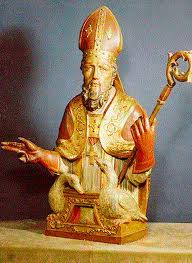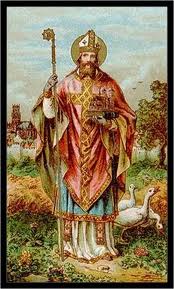
Summary: Following in the footsteps of the English missionary St Boniface, Ludger, who was a native Netherlander, as a priest brought the faith to the people of Frisia in Holland and the Saxons of north-west Germany. He was a gentle patient soul.
Patrick Duffy tells his story.
 A Frisian of noble descent
A Frisian of noble descent
Ludger was born at Zuilen, near Utrecht, in the Netherlands about 742. His parents were wealthy Christian Frisians of noble descent. When he was eleven years of age, he saw the English missionary St Boniface and this made such an impression on him that he became a disciple of St Gregory of Utrecht (friend of St Boniface). He later wrote a Life of St Gregory. He then went to England to study under Alcuin at York for some years (767-771). While there he developed a friendship with Alcuin which lasted through life and was ordained a deacon.
Difficulties preaching the gospel among Frisians and Saxons
In 775 Ludger was sent to revive the work at Deventer in the Netherlands begun by St Lebuin (an Englishman and monk of Ripon, who died 773). He restored the chapel and recovered the relics of St Lebuin. But because of conflict between the Frisians and the Saxons he withdrew and went to teach at Gregory school’s in Utrecht. He was ordained a priest at Cologne in 777. Subsequently he preached the gospel at Dokkum in Friesland, where St Boniface had been put to death.
To Rome and Monte Cassino
Driven out by the Saxons about 785, Ludger went to Rome where he met with Pope Adrian I. He spent the next two years in Monte Cassino, planning to found a Benedictine monastery of his own.
Charlemagne in Friesland and Saxony
At this time Charlemagne was forcefully converting the Frisians and Saxons to Christianity, with the Saxon leader Widukind providing serious opposition. When Ludger returned to the area in 787, Charlemagne entrusted him with the evangelisation of the Saxons in Westphalia. His preaching of the gospel had more success than Charlemagne’s repressive measures. He is reported to have cured the blindness of, and thus caused the conversion of, the blind pagan bard Berulef.
 Canons regular at Münster
Canons regular at Münster
Ludger made his headquarters in the place now called Münster, meaning “monastery”. Here in 795 he founded a community of canons regular, following the Rule of St Chordegang of Metz. In 799 he established a monastery at Werden on the Rhur and became its first abbot. Around 803 he was consecrated bishop of Münster. He was a gentle pastor who achieved much for Christianity by his patient persuasion.
Death and representation
This great missionary died on Passion Sunday 809 while on a preaching tour, and he was buried at the Benedictine monastery of Werden. To avert a dispute, relics were taken to the monastery at Münster. He is variously depicted as a bishop reciting his breviary, or as a bishop holding a cathedral (as above), or a bishop with a swan on either side.
____________________________
******************************
Memorable Saying for Today
Thaw with her gentle persuasion is more powerful
than Thor with his hammer.
Thaw melts, Thor breaks into pieces.
~ Henry David Thoreau ~
******************************